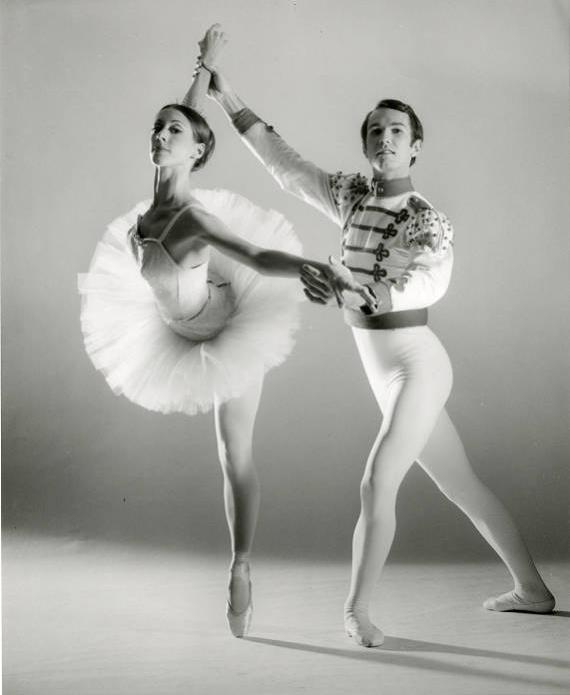Formed in 1973 as an outgrowth of the Civic Ballet Society of Indianapolis (which had been founded in 1959), Indianapolis Ballet Theatre (IBT) initially performed only to audiences. The programs for school children were so successful that they were expanded and eventually received funding from the American Heritage Program, , and state and local agencies. The troupe’s budget was funded primarily by individual donations and income from touring.

In 1976, the IBT opened its season at the Showalter Pavilion in the . In 1978, George Verdak, a former member of the Ballet Russe de Monte Carlo and a renowned choreographer, was hired as full-time artistic director. He had been a professor at Butler University since 1958 and also had directed the . Verdak provided IBT with a strong foundation and created more than 100 ballets for the company. In 1980, while Verdak was artistic director, the troupe survived a fire that destroyed most of its costumes and scenery.
In 1983, Aleksandr “Sasha” Agadzhanov, a 1969 graduate of the Kiev State Academy, who performed with the Moscow Ballet Company and the New York Dance Theatre, was appointed ballet master. He, however, stayed with the company less than a year. In 1984, IBT moved its performances to , and in July 1986, George Montague, who had been a principal dancer and choreographer with the Illinois Ballet and the resident director of the Minnesota Ballet, became ballet master.
By this time, the IBT was composed of 20 professional dancers from across the United States as well as Canada, Japan, and China, who performed in over 50 cities across North America. In 1988, Dace Dindonis, a student of Verdak’s at Butler who had joined IBT as a dancer in 1973 and had served as assistant artistic director beginning in 1977, became the company’s artistic director. A prolific choreographer, she created at least 65 original works for IBT, including everything from classic story ballets to children’s pieces. In 1988, the company also hired Panama native Rosanna Ruffo, a dancer who trained at the Kirov Ballet in St. Petersburg. During her tenure at IBT, she received much praise and performed in many of the ballet’s most difficult leading roles.
From 1985 to 1990, attendance increased from 4,000 to 14,000. After being headquartered in the for 11 years, the IBT moved to a converted office building at 502B North Capitol Avenue in fall 1992. That year, the board of the Indianapolis Ballet Theatre invited Russian dancer Eldar Aliev, who had been a leading soloist for the Kirov (Marinsky) Theatre, to Indianapolis to be the principal soloist for the company.
In February 1994, during the company’s 20th season, the IBT board released Dindonis and appointed Aliev to replace her as interim artistic director. Executive director Kathryn Stephenson also was dismissed.
IBT gained acclaim from New York Times critic Jack Anderson in early April 1994 for its performance of Prokofiev’s Romeo and Juliet, choreographed by Dindonis, at Queensborough Community College in Bayside, New York. In his review, Anderson stated that IBT “presented a convincing and often touching version” of Prokofiev’s ballet, identified IBT costume designers as “a gifted staff,” and described IBT prima ballerina Ruffo as “an eager Juliet, who moved lightly and impulsively, as if wanting to soar upward with every step and gesture.” The New York IBT performance, however, was Ruffo’s last. She left IBT citing disagreements with Aliev. Other key dancers such as Dale Shields, who had played leading roles for the troupe for many years, also left the company.
On May 1, 1994, the Indianapolis News published a review that contrasted starkly with the one that Anderson had written about IBT just a couple of weeks before. Local critic Julie Goldsmith called out Aliev for “scouring Russia, and other international venues” to find dancers for its 20-year anniversary gala concert. She stated that the “imported dancers” failed to “add artistry” and that the “results were disastrous.”
Despite the controversy that resulted from all these changes, the IBT board voted to make Aliev permanent artistic director in late July 1994. He promised “to lead the company to great things.” The company changed its name to Ballet Internationale, corresponding with his aim to create a world-class classical ballet organization for the city of Indianapolis. During his tenure, Alieve produced and choreographed the company’s own versions of Tchaikovsky’s The Nutcracker and Sleeping Beauty, Stravinsky’s Firebird, and many others, and the troupe performed outside Indianapolis in such cities as Los Angeles, Montreal, Beijing, and Taipei.
Aliev’s grand ambitions, however, came with a price. By 2001, Ballet Internationale had accumulated a debt of roughly $700,000. Its board embarked on a major capital campaign, working hard to build support with corporate contributors and to better market itself in the local community. The Lilly Endowment came to the rescue with a major grant. These measures, however, did not suffice.
In the first quarters of 2005, Aliev threatened to move the company. He made a proposal to the Los Angeles Music Center, but to no avail. The history of IBT/Ballet Internationale ended abruptly on November 9, 2005, when the company claimed about $1 million in debt and canceled its season. Indianapolis was left without a professional ballet company until Indianapolis Ballet was founded in May 2017.

Help improve this entry
Contribute information, offer corrections, suggest images.
You can also recommend new entries related to this topic.